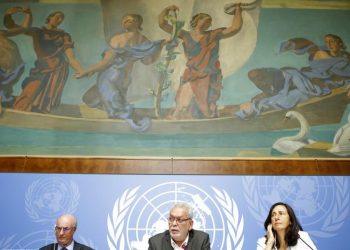International Law and Justice
Among the greatest achievements of the United Nations is the development of a body of international law, which is central to promoting economic and social development, as well as to advancing international peace and security. The international law is enshrined in conventions, treaties and standards. Many of the treaties brought about by the United Nations form the basis of the law that governs relations among nations. While the work of the UN in this area does not always receive attention, it has a daily impact on the lives of people everywhere.
The Charter of the United Nations specifically calls on the Organization to help in the settlement of international disputes by peaceful means, including arbitration and judicial settlement (Article 33), and to encourage the progressive development of international law and its codification (Article 13).
Over the years, more than 500 multilateral treaties have been deposited with the UN Secretary-General. Many other treaties are deposited with governments or other entities. The treaties cover a broad range of subject matters such as human rights, disarmament and protection of the environment.
General Assembly as a forum for adopting multilateral treaties
The General Assembly is composed of representatives from each UN Member State and is the main deliberative body on matters relating to international law. Many multilateral treaties are in fact adopted by the General Assembly and subsequently opened for signature and ratification. The Legal (Sixth) Committee assists the work of the General Assembly by providing advice on substantive legal matters. The Committee is also made up of representatives from all UN Member States.
The General Assembly has adopted several multilateral treaties throughout its history, including:
- Convention on the Prevention and Punishment of the Crime of Genocide (1948)
- International Convention on the Elimination of All Forms of Racial Discrimination (1965)
- International Covenant on Civil and Political Rights (1966)
- International Covenant on Economic, Social and Cultural Rights (1966)
- Convention on the Elimination of All Forms of Discrimination against Women (1979)
- United Nations Convention on the Law of the Sea (1982)
- Convention on the Rights of the Child (1989)
- Comprehensive Nuclear-Test-Ban Treaty (1996)
- International Convention for the Suppression of the Financing of Terrorism (1999)
- International Convention for the Suppression of Acts of Nuclear Terrorism (2005)
- Convention on the Rights of Persons with Disabilities (2006)
- United Nations Convention on Contracts for the International Carriage of Goods Wholly or Partly by Sea (2008)
- Optional Protocol to the International Covenant on Economic, Social and Cultural Rights (2008)
In many areas, the legal work of the United Nations has been pioneering, addressing problems as they take on an international dimension. The UN has been at the forefront of efforts to provide a legal framework in such areas as protecting the environment, regulating migrant labour, curbing drug trafficking and combating terrorism. This work continues today, as international law assumes a more central role across a wider spectrum of issues, including human rights law and international humanitarian law.
Read also about Law of the Sea.
Development and codification of international law
International Law Commission
The International Law Commission was established by the General Assembly in 1947 to promote the progressive development of international law and its codification. The Commission is composed of 34 members who collectively represent the worlds principal legal systems, and serve as experts in their individual capacity, not as representatives of their governments. They address issues relevant to the regulation of relations among states, and frequently consult with the International Committee of the Red Cross, the International Court of Justice and UN specialized agencies, depending on the subject. Often, the Commission also prepares drafts on aspects of international law.
Some topics are chosen by the Commission, others are referred to it by the General Assembly. When the Commission completes work on a topic, the General Assembly sometimes convenes an international conference of plenipotentiaries to incorporate the draft into a convention. The convention is then opened to states to become parties — meaning that such countries formally agree to be bound by its provisions. Some of these conventions form the very foundation of the law governing relations among states. Examples include:
- the Convention on the Non-navigational Uses of International Watercourses, adopted by the General Assembly in 1997, which regulates the equitable and reasonable utilization of watercourses shared by two or more countries;
- the Convention on the Law of Treaties between States and International Organizations or between International Organizations, adopted at a conference in Vienna in 1986;
- the Convention on the Succession of States in Respect of State Property, Archives and Debts, adopted at a conference in Vienna in 1983;
- the Convention on the Prevention and Punishment of Crimes against Internationally Protected Persons, including Diplomatic Agents, adopted by the General Assembly in 1973;
International humanitarian law
International humanitarian law encompasses the principles and rules that regulate the means and methods of warfare, as well as the humanitarian protection of civilian populations, sick and wounded combatants, and prisoners of war. Major instruments include the 1949 Geneva Conventions for the Protection of War Victims and two additional protocols concluded in 1977 under the auspices of the International Committee of the Red Cross.
The United Nations has taken a leading role in efforts to advance international humanitarian law. The Security Council has become increasingly involved in protecting civilians in armed conflict, promoting human rights and protecting children in wars.
Judicial settlement of disputes
International Court of Justice
The primary United Nations organ for the settlement of disputes is the International Court of Justice. Also known as the World Court, it was founded in 1946. Since its founding, the Court has considered over 170 cases, issued numerous judgments and issued advisory opinions in response to requests by UN organizations. Most cases have been dealt with by the full Court, but since 1981 six cases have been referred to special chambers at the request of the parties.
In its judgments, the Court has addressed international disputes involving economic rights, rights of passage, the non-use of force, non-interference in the internal affairs of states, diplomatic relations, hostage-taking, the right of asylum and nationality. States bring such disputes before the Court in search of an impartial solution to their differences based on law. By achieving peaceful settlement on such questions as land frontiers, maritime boundaries and territorial sovereignty, the Court has often helped to prevent the escalation of disputes.
International Criminal Justice
The international community had long aspired to create a permanent international court to try the most serious international crimes, and, in the 20th century, it reached consensus on definitions of genocide, crimes against humanity and war crimes.
Tribunals
After the Second World War, the Nuremberg and Tokyo trials addressed war crimes, crimes against peace, and crimes against humanity committed during the Second World War.
The ad hoc tribunals and UN-assisted tribunals have continued to contribute to combating impunity and promoting accountability for the most serious crimes. In the 1990s, after the end of the Cold War, the International Criminal Tribunals for the former Yugoslavia (ICTY) and for Rwanda (ICTR) were established to try crimes committed within a specific time-frame and during a specific conflict. This applies, as well, to three courts established by the states concerned, but with substantial UN support: the Special Court for Sierra Leone (2002), the Extraordinary Chambers in the Courts of Cambodia (2006) and the Special Tribunal for Lebanon (2007). Sometimes referred to as ‘hybrid’ courts, they are non-permanent institutions which will cease to exist once all their cases have been heard.
The International Criminal Court
The idea of a permanent international court to prosecute crimes against humanity was first considered at the United Nations in the context of the adoption of the Genocide Convention of 1948. For many years, differences of opinions forestalled further developments. In 1992, the General Assembly directed the International Law Commission to prepare a draft statute for such a court. The massacres in Cambodia, the former Yugoslavia and Rwanda made the need for it even more urgent.
The International Criminal Court (ICC) has jurisdiction to prosecute individuals who commit genocide, war crimes and crimes against humanity. It will also have jurisdiction over the crime of aggression when an agreement is reached on the definition of such a crime. The ICC is legally and functionally independent from the United Nations, and is not a part of the UN system.
The cooperation between the UN and the ICC is governed by a Negotiated Relationship Agreement. The Security Council can initiate proceedings before the ICC, and can refer to the ICC situations that would not otherwise fall under the Court’s jurisdiction. The Court has 18 judges, elected by the states parties for a term limited to nine years, except that a judge shall remain in office to complete any trial or appeal which has already begun. No two judges can be from the same country.










